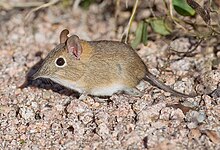Bushveld elephant shrew
| Bushveld elephant shrew[1] | |
|---|---|

| |
| Scientific classification | |
| Domain: | Eukaryota |
| Kingdom: | Animalia |
| Phylum: | Chordata |
| Class: | Mammalia |
| Order: | Macroscelidea |
| Family: | Macroscelididae |
| Genus: | Elephantulus |
| Species: | E. intufi
|
| Binomial name | |
| Elephantulus intufi (A. Smith, 1836)
| |

| |
| Bushveld elephant shrew range | |
The bushveld elephant shrew or bushveld sengi (Elephantulus intufi) is a species of elephant shrew in the family Macroscelididae. It is found in Angola, Botswana, Namibia, and South Africa. Its natural habitats are subtropical or tropical dry shrubland and hot deserts.[2]
Behavior[edit]
The bushveld elephant shrew live in monogamous pairs within their own territory away from other pairs which can be attributed as a result of male mate guarding. Even though they live as monogamous pairs, the bushveld elephant shrew experience weak pair bonds.[3]
According to the journal “Social Structure of the Bushveld Sengi (Elephantulus Intufi) in Namibia and the Evolution of Monogamy in the Macroscelidea” written by G. B. Rathburn and C.D. Rathburn, the behavioral ecology of elephant shrews is best understood in the context of their evolutionary history. There is strong evidence that their phylogeny is due to Macroscelidea which is part of a monophyletic African clade of mammals that represents one of four early eutherian radiations.[3]
References[edit]
- ^ Schlitter, D.A. (2005). Wilson, D.E.; Reeder, D.M. (eds.). Mammal Species of the World: A Taxonomic and Geographic Reference (3rd ed.). Johns Hopkins University Press. pp. 82–83. ISBN 978-0-8018-8221-0. OCLC 62265494.
- ^ a b Rathbun, G.B. (2015). "Elephantulus intufi". IUCN Red List of Threatened Species. 2015: e.T42661A21289808. doi:10.2305/IUCN.UK.2015-2.RLTS.T42661A21289808.en. Retrieved 13 November 2021.
- ^ a b Rathbun, G. B.; Rathbun, C. D. (2006). "Social structure of the bushveld sengi (Elephantulus intufi) in Namibia and the evolution of monogamy in the Macroscelidea". Journal of Zoology. 269 (3): 391–399. doi:10.1111/j.1469-7998.2006.00087.x. ISSN 1469-7998.

